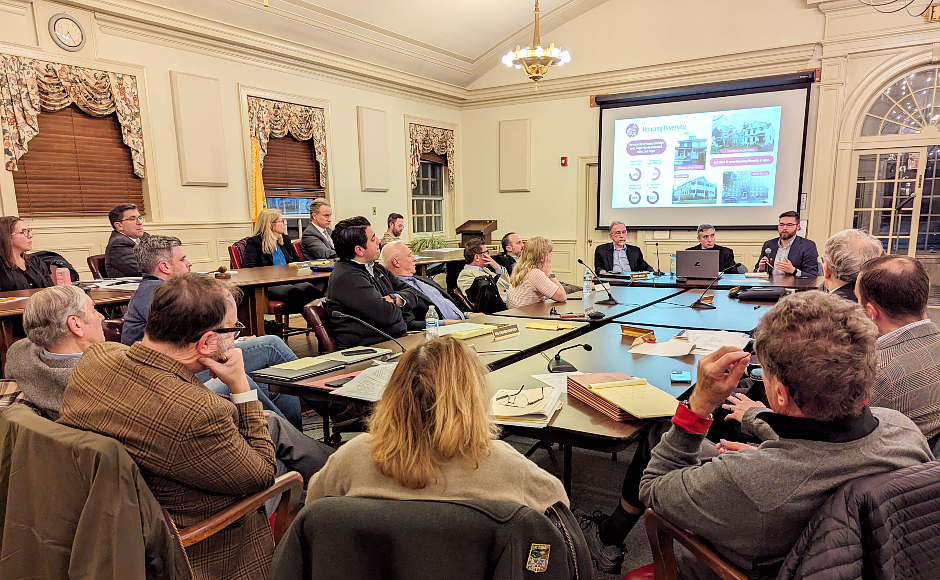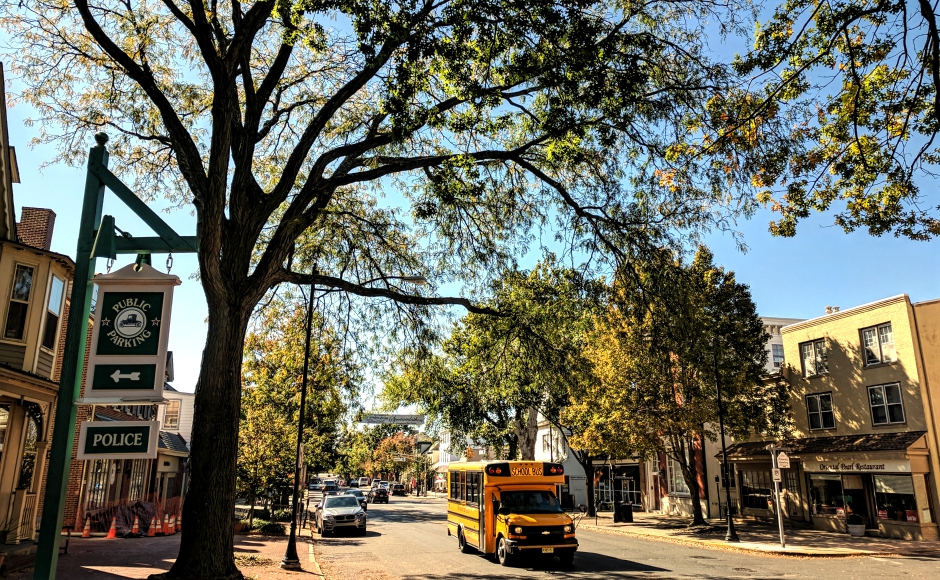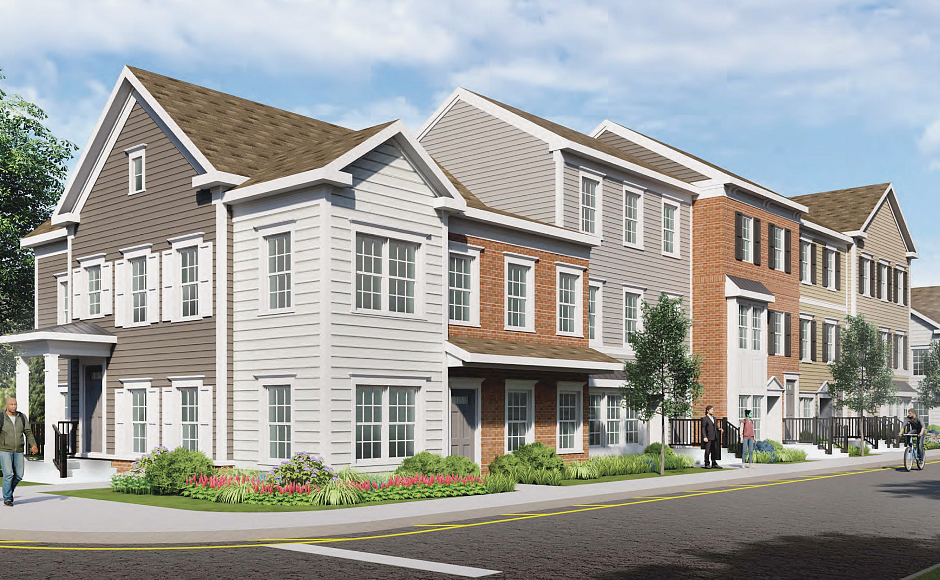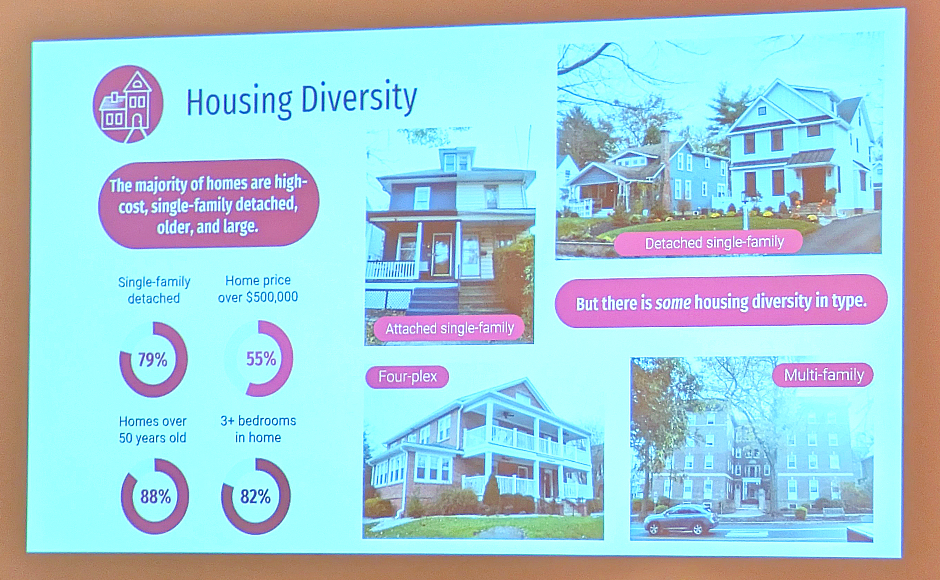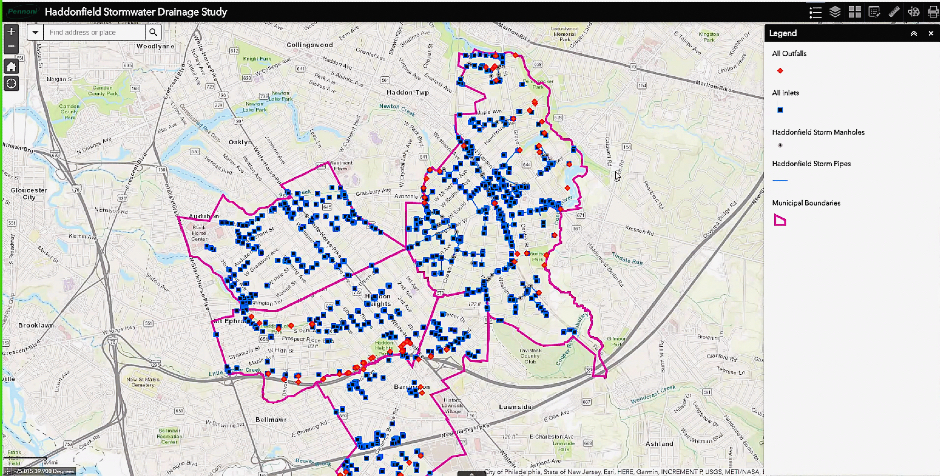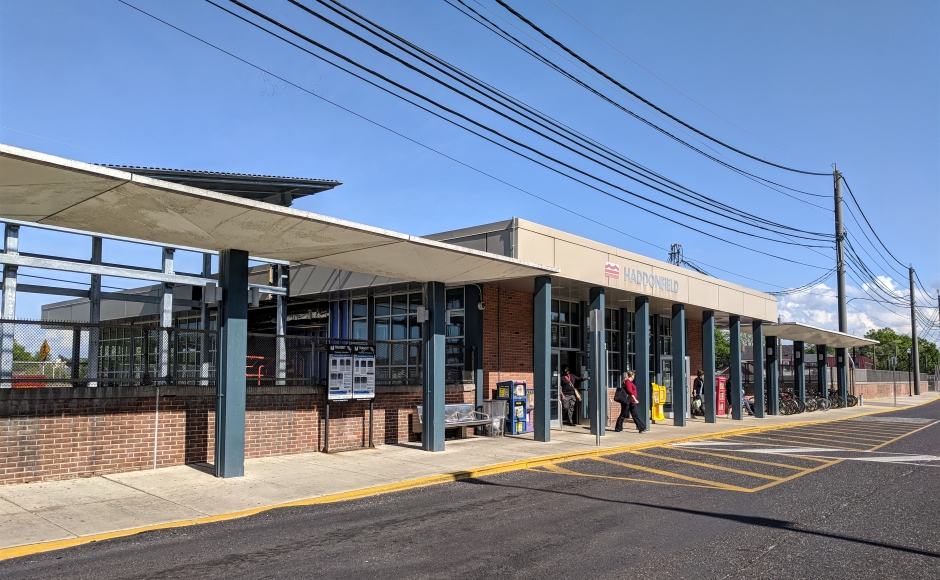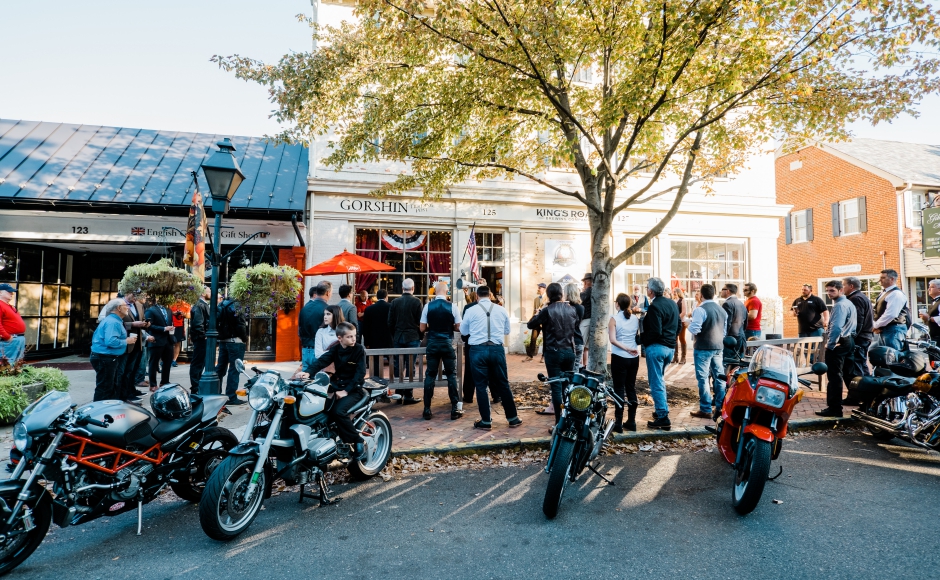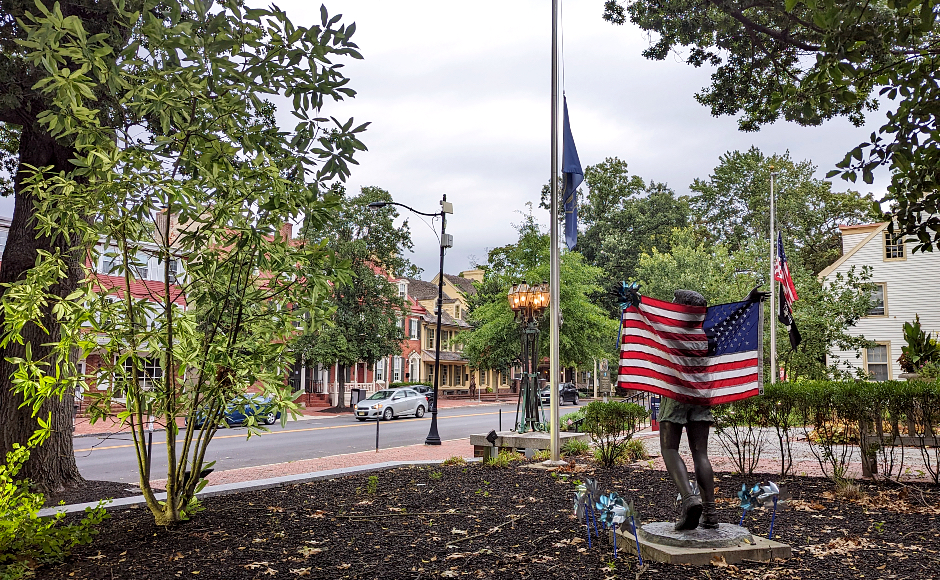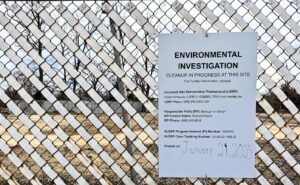In a listening session about the borough master plan update, Pennoni consultants heard pushback from Haddonfield land use board appointees on issues of multifamily housing, parking availability, and ‘overloaded schools.’
By Matt Skoufalos | February 28, 2024
As Haddonfield continues the months-long process of updating its borough Master Plan, professionals from the Philadelphia-based Pennoni consultancy met with members of its municipal land use boards to solicit their feedback on four key areas of the study.
At Tuesday night’s special meeting, members of the borough Planning and Zoning Boards, Historic Preservation Commission, and general public discussed how the Haddonfield master plan update will consider issues of resiliency, housing diversity, downtown economic vitality, and traffic circulation.
Respectively, those elements concern:
- the capacity of the borough to withstand the effects of climate change in the coming decade
- how to address unmet needs in its housing inventory
- ways to fortify and improve the viability of the local business district
- how to support safer, more efficient modes of travel for bicyclists, pedestrians, and motorists.
Any revisions to municipal land use law that emerge from the guidance established by the updated plan will pass through the hands of the local governing bodies, who will hear planning and zoning cases before and after the update. Pennoni Senior Planner Stan Slachetka advised them to hear the public feedback generated by the update process to date in light of that fact.
“These are the things that the community is asking you to figure out,” Slachetka said. “You’re the ones to figure out the correct balance.”
Housing Diversity
The bulk of the conversation Tuesday centered on the first item of business: addressing unmet needs in the diversity of local housing stock.
Pennoni Planning & Urban Design Director Matt Wanamaker described foundational issues identified by community surveys undertaken during the Master Plan update.
Respondents reported that Haddonfielders love living in the borough, but have difficulty finding housing types that could allow them to age in place. The price of housing in the borough is “a major barrier to entry” for new families, and a limiting factor in housing options, Wanamaker continued.
Similarly, respondents voiced concerns about the ever-increasing sizes of borough homes that stretch to maximum surface-area coverages, often as a result of older, historic properties being demolished in favor of structures built to setback limits.
“The majority of homes are high-cost, single-family-detached, older, and large,” Wanamaker said. “There is an unmet demand for these other housing types within the borough.”
To his point, Pennoni presented graphics that illustrated the scope of the issue: 79 percent of homes in the borough are single-family detached, 82 percent contain three or more bedrooms, 88 percent are more than 50 years old, and 55 percent have prices of more than a half-million dollars apiece.
Among the solutions the planners have considered, which they raised with the boards, is how “missing middle” housing might fit into the current borough planning calculus. Missing middle housing refers to a range of multi-unit building types that can be integrated into existing residential or mixed-use housing contexts without dramatically altering the surrounding environment.
Duplexes, triplexes, quads, townhomes, and courtyard apartments are all types of the “missing middle” housing element that exists in the range between detached, single-family homes and denser mid- or high-rise multi-unit buildings.
“We propose making incremental changes to the zoning code to allow for more missing middle housing opportunities as opposed to a whole revamp,” Pennoni Senior Planner Geoffrey Gray-Cornelius said.
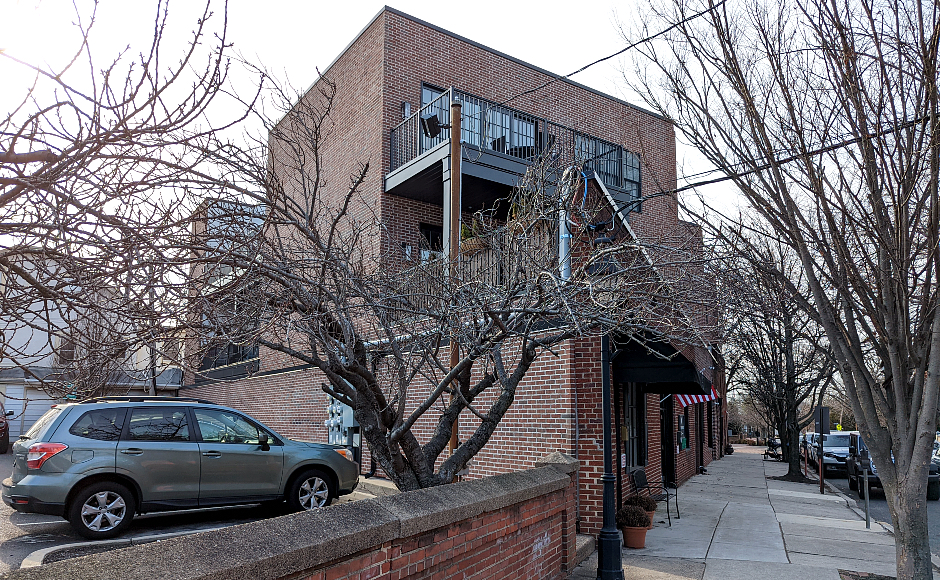
Redevelopment of a mixed-use building on Haddon Avenue added residential units above a commercial space. Credit: Matt Skoufalos.
Wanamaker stressed that any efforts to achieve these ends would be undertaken within the context of the surrounding built environment “where they are already present, and will not otherwise interfere with existing zoning… focusing on conditional use, not by-right.
“We’ve been very careful about selecting locations and types” in the context of “what already exists,” he said.
Haddonfield Borough Administrator Sharon McCullough spoke about “ensuring that the ability to create duplexes and twins” could occur without demolition. She mentioned the possibility of developing a zoning overlay that offers those options “within the existing confines of the existing house,” and without changing its exterior footprint.
The consultants also spoke about not wanting any missing middle development to exacerbate building coverage limits; presently, “well over half” the properties in town exceed what’s permitted, Wanamaker said.
Another opportunity to resolve the housing diversity question in Haddonfield would be to allow detached accessory dwelling units, or ADUs, “in appropriate locations” across town, Slachetka said. Under such a mechanism, certain property owners might be able to convert a detached garage or carriage house into living space to allow seniors or college-aged family members to stay together.
“We want to be very strategic,” he said. “We are looking at places where it is acceptable and can be a success, and provide the foundation for the possibility in other areas if it works.”
The timeliness of the issue was underscored in Governor Phil Murphy’s fiscal 2025 budget plan, which includes a $10-million appropriation to help communities incentivize homeowners to create new ADUs or convert existing units into them. The document describes how these funds “will allow towns to diversify the types of housing they can use in their affordable housing settlements, and incentivize towns to adopt or revise ADU ordinances so that more ADUs can be developed in New Jersey.”
But no sooner had the topic of multifamily housing been raised Tuesday night than board members pushed back at the very suggestion.
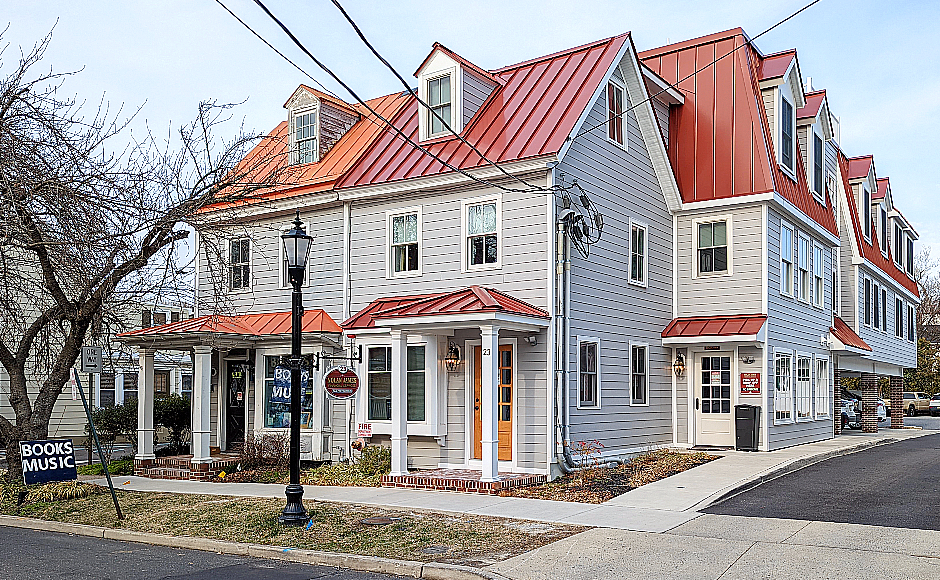
Mixed-use projects, like this one on Tanner Street in Haddonfield, showcase the potential for infill growth in the borough. Credit: Matt Skoufalos.
Planning Board Member Stuart Harting spoke about the premium price that Haddonfield homeowners paid to move into the community with the understanding of buying into single-family-home neighborhoods.
“To a lot of people who buy their homes here, this is one of the most important investments they’ll have in their lives,” Harting said.
“The equity in their home is very important to them,” he continued.
“To move into an area and find out that they have multifamily next to them, that’s a problem for a lot of people.”
Planning Board member Douglas McCollister said that the governing bodies should be more focused on stopping teardowns rather than accommodating a variety of residential building types, adding that he believed “there’s a lot of big garages that have already been converted to ADUs.”
Zoning Board member Lindsey Watson-McCarthy expressed fears that a borough resident building an ADU would rent it to “some couple from Philadelphia who’s dying to get their kids into our school.”
Her colleague, Zoning Board member Brittany Bonetti followed a similar train of thought, asking the consultants, “Are your recommendations tempered by the fact that the schools are overloaded?”
That led Zoning Board alternate member Katherine O’Neil to hypothesize that creating multiple-bedroom apartments would only invite families to overcrowd them with more children than the borough public schools can manage.
“There’s a variety of housing stock near Central School that has single-family homes and apartments in that area,” O’Neil said. “Someone in that area is going to be concerned that they’re in an R7 [residential zone], but then their neighbor could convert a single-family home to a duplex. R7 allows it, but there’s never been a duplex in that whole section of the neighborhood prior to.”
Zoning Board member William Shanahan dismissed the concept out of hand with a single question: “I just want to know where are they going to park?”
“Parking is going to be one of the biggest constraints that doesn’t allow this to explode,” Gray-Cornelius responded. “Parking is going to be a major constraint; impervious coverage is going to be a major constraint.
“There are a lot of homes where the lot isn’t appropriate [for multifamily development],” he said. “It’s unlikely they would meet the standard to allow these other uses. Some of the uses that we’re proposing, we’re trying to minimize the impact on the zone, to have the change be as minimally invasive as possible.”
“We don’t want to undermine resiliency by increasing imperious surface coverage to the point that it affects stormwater damage,” Wanamaker added.
Slachetka reminded the board members that the master planning process on the whole offers them the opportunity to control comprehensively how the community develops over the next decade.
“By just doing this analysis, and doing this in a way that’s very detailed, you’ll be able to more specifically define the regulatory framework by which a developer is going to be able to do something or not do something,” he said. “And you’ll have the benefit of a very recent update having just reviewed these regulations.”
Resiliency
The Master Plan update also involves a climate-change-related hazard vulnerability assessment (CCRHVA), which focuses on how land use elements of the master plan can be leveraged to identify threats and mitigate their impacts.
Resiliency work involves identifying critical facilities, roadways, utilities, and infrastructure in the borough, analyzing the impact of natural hazards on the master plan, and developing strategies and design standards that take the most significant hazards into account.
The two most immediate impacts of climate change that Haddonfield faces are stormwater flooding and increasing temperatures. Although the borough “should get a lot of credit for its high level of tree cover” and the heat mitigations that canopy provides, Wanamaker said, 40 percent of Haddonfield is covered by impervious surfaces, which absorb and retain heat.
The biggest challenge for the borough is that it lacks the built infrastructure to manage stormwater, which “is not directed throughout the town in any way it wouldn’t already go,” McCullough said.
“There are no sump pumps or pumping stations,” she said. “We are a very old town that was built out before most infrastructure was even thought of, and trying to implement infrastructure after the fact is very difficult. Everything has been compounding the problem.”
Especially given those circumstances, Haddonfield Mayor Colleen Bianco Bezich spoke about the need to form partnerships with neighboring communities, the stormwater runoff from which affects Haddonfield as well.
“We can solve all the issues of Haddonfield, and it doesn’t mean that Audubon or Heights won’t still contribute [to it],” the mayor said.
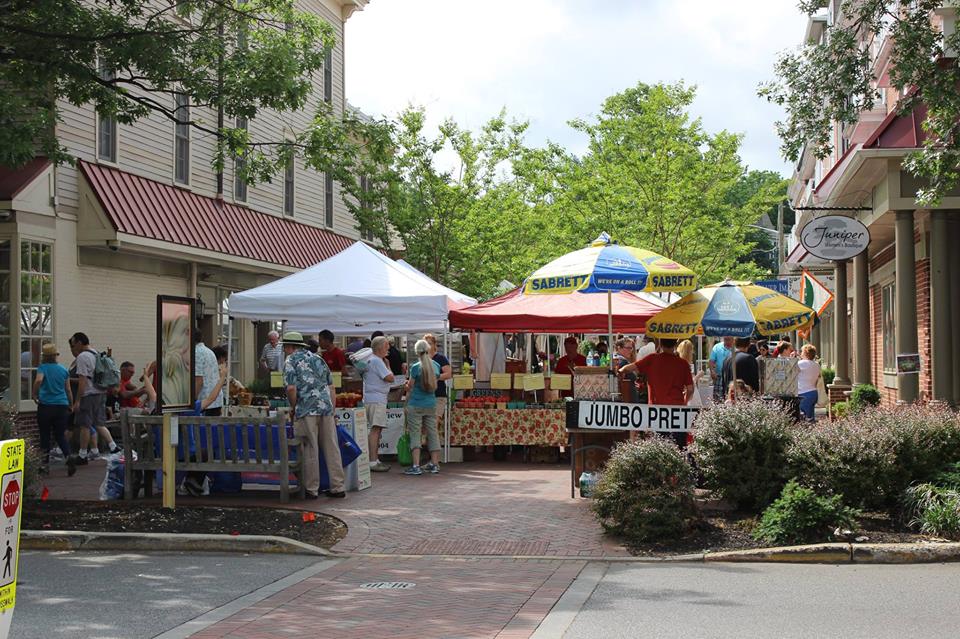
The Haddonfield Farmers Market in King’s Court contributes to the vitality of the borough downtown shopping district. Credit: Haddonfield Farmers Market (2018).
Downtown Economic Vitality
The Haddonfield downtown dining and shopping district remains a regional draw among those respondents to the Master Plan survey: 65 percent of respondents walk to get downtown versus 33 percent who drive.
Of those who responded to the survey, 91 percent visit at least weekly, 54 percent go weekly, and 37 percent visit the borough downtown daily, all strong numbers, Gray-Cornelius said.
Challenges for the district include its lack of space and activities to engage children and teenagers; although young people congregate downtown, “there’s not really a direction or an outlet for them to expend their energy,” Wanamaker said.
The walkability of the downtown district is one of its strengths, and expanding the ease of navigating it on foot is a challenge for the coming years, the consultants said. Amid the growth in online retail and remote work in the wake of the novel coronavirus (COVID-19) pandemic, more Haddonfielders are working from home than in nearby communities, the planners said.
Although ridership on the PATCO Speedline hasn’t rebounded since the pandemic receded — it’s at less than half its prior level, Gray-Cornelius said — the borough should consider ways to connect the surrounding residential neighborhoods to the Haddonfield station.
“There’s no real obvious connection from where you exit the station and come downtown,” he said, suggesting that borough leaders begin working with PATCO “to find opportunities to create that connection.”
Other challenges for the borough downtown include managing parking and pedestrian needs in the shopping district, particularly along Haddon Avenue and Kings Highway. Zoning Board Chair Wayne Partenheimer spoke about how handicap parking is especially at a premium in the central business district.
The district also lacks public bathrooms, and not all of its sidewalk ramps and curb cuts are compliant with the Americans with Disabilities Act (ADA).
Some of the biggest downtown challenges persist as a function of cost; Bianco Bezich spoke about the cost of engineering a curb cut at the PATCO bridge over Kings Highway as around $1 million by itself.
“The reason we don’t have a crosswalk signal [there] is because it’s against ADA guidance to advertise it as a safe crosswalk,” she said, “because if you are in need of accessibility, it is not a curb that you can access.
“We can’t put more striping there because it is not an appropriate place for those in need of accessibility to cross.”
Circulation
Finally, on the subject of traffic circulation in the borough, the planners discussed “the perception that traffic is increasing, and drivers are using residential streets to bypass major intersections,” which emerged from its community surveys.
Among the challenges to contemplate for the future of the borough are: finding places to implement traffic calming and traffic control measures; designating a bicycle network of key destinations, including the downtown, schools, and parks; enhancing the local pedestrian network; and collaborating with PATCO to enhance connections and ridership.
O’Neil spoke about the walkability of the local school district as being compromised by a lineup of cars at drop-off and pickup times.
“You just don’t drive through that section of town at that time,” she said. “I think that is an aspect where we need some recommendations; how do we alleviate that?”
Bianco Bezich described pedestrian safety as “the number-one concern that gets raised” to local law enforcement, and spoke about the need to address it while also making sure the borough is compliant with uniform traffic control standards.
Recapping the results
After the meeting, the mayor expressed her gratitude with the board members for attending and contributing to “a collaborative conversation.
“These elements are all interconnected; there’s no easy answers, and things cost time and money to resolve,” she said.
However, Bianco Bezich said she was less enthusiastic about some of the perspectives the board members seemed to demonstrate around residential zoning issues — namely, the notions expressed that the schools are overfull, or that the town couldn’t accommodate multifamily housing without betraying some unspoken covenant with single-family homeowners.
“It’s very troublesome to hear people assert that no one new is welcome here,” Bianco Bezich said.
“It’s troublesome to me to hear a focus on preserving only the folks who live in town already to remain in affordable types of housing, and to couch other types of affordable or achievable homes as problematic.
“There’s a reason that New Jersey has some of the most segregated communities,” she said.
“There’s a reason that affordability is what it is, and we’re facing the housing crisis we have. I want people to be able to age in place. I also want individuals, families of all types, of all income levels, to be able to access this community.”
Moreover, the mayor said she didn’t understand how those reactions squared with the consultants’ remarks, as they emphasized that revisions to the Master Plan would be limited in these areas; that “incrementalism is all that’s possible” in the largely built environment of the borough.
“Everybody likes to cite the influx of schoolkids with new construction, or the construction of dense-style housing, when denser housing trends in the opposite direction, particularly market-rate,” Bianco Bezich said. “If you’re downsizing the seniors, their four- and five-bedroom homes in the larger, single-family tracts are attractive to people with small children.
“Those individuals are sending four kids to the school district no differently than someone would be with their two- or three-bedroom condo,” she said. “And I do really struggle with the focus on only seniors living here. That’s a real challenge for us.”
Likewise, conversations about the achievability of affordable housing in Haddonfield — of which there is a 400-unit deficit, according to McCullough — remain largely theoretical, as much of the land the borough has banked in its affordable housing discussions is privately owned. Compounding the challenge of attracting broader-scale affordable housing redevelopment is the fact that the borough is too wealthy and racially homogenous to qualify for either population-based or need-based funding to incentivize such projects.
“When they calculate our realistic development potential, or unmet need, the challenge for us is look at what our market-rate values already are,” Bianco Bezich said.
“I would love to transition to deed-restricted [affordable housing] where it already exists, [but] I have to spend $700,000 to buy one of those and make it an affordable unit,” she said. “And when I go to the state to say, ‘Give me funding,’ they say, ‘You’re Haddonfield; you don’t qualify.’ Then I only have trust fund dollars to purchase [affordable units], or have to convince certain landlords to deed-restrict.”
The Haddonfield Master Plan update process will continue for a while yet. The next public meeting with Pennoni consultants will be held in the borough on March 26.

